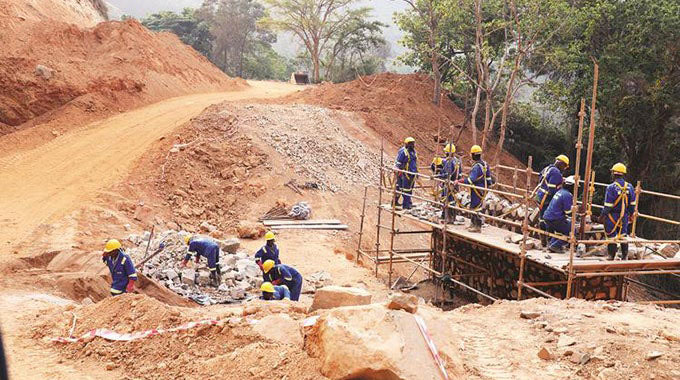Post-disaster recovery plan crucial

Jeffrey Gogo Climate Story
History is littered with cases of unresolved post-disaster catastrophes. In the majority of instances, public infrastructure damaged or destroyed during periods of excessive rain in Zimbabwe could go unrepaired for decades, largely as a result of a lack of funds, will power and poor planning.
Damage from Cyclone Eline of the early 2000s bears testament. Then there is the Chingwizi flood victims in Masvingo province from three years ago. In recent memory, however, one disaster stands out as the devilish example of how difficult it could be for anyone to reconstruct communities flattened by climate change-linked extreme events like flooding.
In March 2019, Cyclone Idai ripped through Zimbabwe, neighbouring Mozambique and Malawi, killing around 1 300 people across the three southern African countries. The cyclone accumulated damage to both public and private infrastructure that will cost up to US$4 billion to rebuild.
United Nations chief Antonio Guterres described the cyclone as one that rang “yet another alarm bell about the dangers of climate change”. With homes buried under mud and rock, Mr Guterres last year exasperated that Cyclone Idai was “an uncommonly fierce and prolonged storm”.
In Chimanimani, thousands of homes were destroyed and hundreds of thousands of people were displaced while public utilities such as schools, bridges and clinics also suffered extensive damage. About 95 percent of the roads in affected areas were damaged.
One year on, reconstruction is still ongoing, but, according to Press reports, a large number of those people affected are still surviving on hand-outs, living in tents, away from their usual cement and brick houses under grass, asbestos or corrugated iron sheets.
Despite a most swift response from ordinary Zimbabweans, Government and global donors, the relief effort in Chimanimani prioritised provision of the more urgent needs for victims such as food, clothing, healthcare and shelter, as it rightly should have done.
But what about long-term recovery; the roads, schools, clinics and bridges etc.? And what happens to the debris, how is it cleaned up and disposed? In the haste to recover, politicians often resort to quick-fix solutions that may not always consider the long-term future of those affected, at least in any reasonable practical way.
Which is why it is not surprising that some bridges destroyed by Cyclone Eline in 2000 in Chipinge were only rebuilt a few years ago and why Chingwizi villagers are still trapped in unsanitary conditions three years on. Much of the infrastructure destroyed by Cyclone Idai in Chimanimani remains in tatters, reports say.
Indeed, post-disaster recovery could become a long and arduous process for governments that do not plan adequately for such an eventuality, and for those whose national budgets are sharply constrained by lack of money vis-a-vis competing demands from other social programmes like healthcare and education.
Both cases are true for Zimbabwe. However, with the famed skill-set at the country’s disposal, it is also a question of lack of foresight as well as commitment by Government to make the necessary financial investments into building modern capabilities and mechanisms to dealing with natural disasters.
For example, strong early warning systems are regarded as a major defence against disasters. Yet, for the past two decades, scientists at the Meteorological Services Department have operated without important equipment such as weather radars.
Radars at Harare, Bulawayo, Victoria Falls and Buffalo Range in Chiredzi stopped working nearly 20 years ago after reaching the end of their 30-year lifespan and the MSD has for a long time pressured Government to release funds for their purchase.
According to experts, the radar is able to provide precise, area-specific forecasts of severe weather and climate occurrences. Extreme events such as tropical storms or hail can be accurately detected a day, even hours, before they occur or as they build up, they say.
It is only in the last year or so that Government agreed to provide US$5,2 million for the acquisition of five weather surveillance. It is not clear whether the money has actually been released.
“There is a need to focus on the whole disaster risk management or climate information value chain,” climate researcher Elisha Moyo told The Herald Business & Finance.
“The Civil Protection Unit (CPU) should play a co-ordinate role where the critical civil protection member institutions are themselves strengthened since the weakest node of a system determines its ultimate strength,” he opined.
Post-emergency situations are not periods for hero-acting. They are humanitarian crises of the highest order, requiring quick, pragmatic decisions by a focal body, in Zimbabwe’s case, the CPU, through collaborative efforts with citizens, development agencies, NGOs, governments and any other interested parties.
Because amid the shock and devastation of a disaster, everything becomes an emergency, what does and what should happen next is not always what is expected, mainly because of inadequate preparedness — apparently, a major hindrance to Zimbabwe’s efforts.
Seismologist and climate expert Kwangwari Jera Marimira inquisitively observed: “With all these disasters where is the New Disaster Management Bill? Why has it not been fast tracked in Parliament? Is it still relevant or it already needs another review before it has been passed?
“Capacitating our institutions is key. You can only communicate what you have and using the available means. There is need to do more to get more detailed and area specific forecasts.”
UN guidelines recommend a rapid assessment of damage in the first 72 hours after a crisis hits, with a focus on clearing roads to ensure emergency vehicles can access affected areas. Dealing with dangerous and harmful materials is also a priority.
However, once the immediate dangers are dealt with, a more detailed assessment of the damage and plans for dealing with it are developed. All this works well through collaboration, but also because there are national laws that support pre-disaster planning to the effect of speeding up response during an emergency to preserve life and property.
God is faithful.









Comments